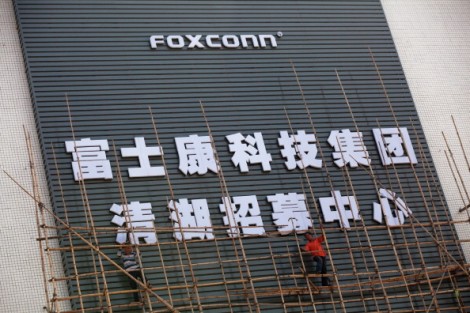Foxconn Dangles $10 Billion Tech Investment to Create U.S. Jobs
The world’s largest maker of iPhones is readying $10 billion or more of investment across several U.S. states.
June 23, 2017

(Bloomberg) -- Terry Gou is intent on building Foxconn Technology Group’s international footprint.
The world’s largest maker of iPhones is readying $10 billion or more of investment across several U.S. states, starting with a decision by July on the location for a $7 billion display-making plant. Foxconn’s billionaire chairman also vowed to press on with a bid for Toshiba Corp.’s semiconductor business -- a deal that could cost $27 billion and usher Foxconn into the memory chip business.
The founder of Foxconn, whose main listed arm is Hon Hai Precision Industry Co., is now weighing the pros and cons of locating the factory in one of several U.S. states, including Wisconsin. Taiwan’s richest man said he’d been in dialog with the White House and various state governors -- one of whom called him moments before he kicked off Thursday’s shareholders meeting. A cutting-edge plant in the Midwest would mark a victory for President Donald Trump and his effort to bring jobs back to America.
“Our investment in the U.S. will focus on these states because they are the heart of the country’s manufacturing sector,” he told investors. “We are bringing the entire industrial chain back to the traditional manufacturing region of the U.S. That may include display making, semiconductor packaging and cloud-related technologies,” Gou told reporters later, without elaborating.
Gou said the plant could be in one of six states without naming all of them. He later said Foxconn’s U.S. investments could be in seven states, naming Ohio, Pennsylvania, Michigan, Illinois, Wisconsin, Indiana and Texas. The company could end up creating “tens of thousands” of American jobs, Gou said without specifying a timeframe for the $10 billion in investment.
Hon Hai, the world’s largest manufacturer of consumer electronics, has steadily expanded production outside of its main base in China and also invested in new spheres of technology. Gou promised investors he’ll continue the pursuit of Toshiba’s prized memory chip unit -- even though it had never been among the frontrunners and the Japanese company’s stated its clear preference for a bid led by Bain Capital and local government-backed companies.
The billionaire blasted government agencies for pushing an in-house deal, saying it was a “minority of bureaucrats” who’re promoting a Japanese-led offer. Gou, who has been vocal about his desire to land the deal, didn’t go into details but reminded investors how Hon Hai beat out rivals for Sharp Corp. in 2016. Hon Hai is said to have considered offering as much as 3 trillion yen ($27 billion) to force Toshiba to take its bid seriously, and had been in talks to rope in allies such as Apple Inc. -- its largest customer.
“The Toshiba deal isn’t over. It is similar to Sharp’s story,” he said. “I believe we still have a big chance.”
The billionaire however focused primarily on Hon Hai’s plans for the longer term. Apple’s main manufacturing partner, which does most production in China, makes everything from smartphones to PCs with a growing clout that has seen it courted by governments around the world.
Gou promised to ramp up investment in the U.S., possibly helping with a rust-belt economic revival. Dubbed “Flying Eagle,” Foxconn’s plan to build a U.S. facility could create tens of thousands of American jobs during Trump’s first year in office. The company is considering a joint investment with Sharp, but details have yet to be hammered out.
In the nearer term, Hon Hai’s shares are riding high as Apple prepares to unveil its latest iPhone -- one of the most-anticipated devices of 2017. The shares closed little changed in Taipei after reaching a record earlier this week.
Hon Hai reported first-quarter earnings short of estimates after a stronger Taiwan dollar squeezed profit in the lull before the new iPhone. That came after a year in which smartphone shipments grew at their slowest pace on record and PC demand continued to flounder. In 2016, Hon Hai’s sales fell 2.8 percent while net income rose just 1.2 percent. Gou said Thursday that revenue and profit this year would be better.
Over the longer term, Gou is re-tooling Foxconn for the future, installing robots to offset rising labor costs in China. It’s also investing in emergent fields from virtual reality to artificial intelligence.
Hon Hai makes a wide range of electronic devices from HP laptops and Xiaomi handsets to Sony PlayStation game consoles. But Apple is by far its most important client, yielding roughly half the company’s revenues.
“Although our profit didn’t see a rapid expansion, we didn’t cut a cent in our annual R&D budget,” Gou said. “We have been accumulating some technologies that will drive long-term growth.”
About the Author
You May Also Like









